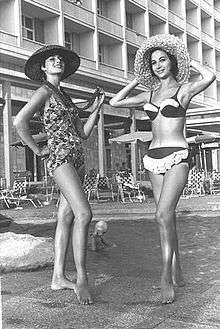Lea Gottlieb
| Lea Gottlieb | |
|---|---|
 | |
| Born |
Leah Lenke Roth[1] September 17, 1918 Sajószentpéter, Hungary |
| Died |
November 17, 2012 (aged 94)[1] Tel Aviv, Israel |
| Residence | Tel Aviv, Israel |
| Nationality | Israeli |
| Other names | Lady Leah[2] |
| Occupation | Fashion designer, businesswoman |
| Known for | Founder and chief designer of Gottex |
| Spouse(s) | Armin Gottlieb |
| Children | Judith Gottlieb and Miriam Ruzow |
Lea Gottlieb (September 17, 1918 - November 17, 2012) was an Israeli fashion designer and businesswoman.[1] She immigrated to Israel from Hungary after World War II, and founded the Gottex company.[3][4][5][6]
Biography
Lea Lenke Roth (later Gottlieb) was born in Sajószentpéter, Hungary. Before World War II began, she was planning to study chemistry.[2] During Germany's occupation of Hungary in the mid-1940s, her husband Armin was shipped to a labor camp.[2] Gottlieb—who was Jewish—hid from the Nazis in Sajószentpéter and Budapest, moving from one hiding place to another with her daughters Miriam and Judith.[2] At checkpoints, she hid her head in a bouquet of flowers to avoid being recognized as a Jew.[6][7][8] Once, after seeing a Nazi with a pistol, she concealed herself and her children in a pit behind a house.[7][9]
Fashion career

Gottlieb and her family survived the war, and after the liberation, she and her husband ran a raincoat factory in Czechoslovakia.[6] They immigrated to Haifa, Israel in 1949.[7] She recalled: "We came with nothing, without money, with nowhere to live. The first two or three years were very, very hard."[7][8]
With money borrowed from family and friends, she and her husband opened a similar raincoat factory near Tel Aviv in 1949.[5][8] But for months, they “saw no rain, only sunshine.”[5][7]
As a result, in 1956 they founded Gottex, a high-fashion beachwear and swimwear company that became a leading exporter, shipping to 80 countries.[3][6][7][8] The company's name is a combination of "Gottlieb" and "textiles".[10]
Gottlieb, a seamstress, began by selling her wedding ring to raise money to buy fabric.[9][11] She borrowed a sewing machine, and sewed swimsuits in their Jaffa apartment.[9][11]
She was the company’s chief designer.[7][12][13] As the company expanded, Gottlieb created beach outfits by complementing swimsuits with matching tops, pareos, caftans, tunics, loose pants, small corsets and skirts.[14] Her collections often had dramatic and varied patterns that were inspired by and dominated by flowers, which she felt had saved her life during the Nazi occupation.[6][13][14][15][16][17][18]
In 1973, when the Yom Kippur War broke out, Gottlieb canceled a foreign tour, took over operations at Gottex, and arranged fashion shows for front-line soldiers.[3] By 1984, Gottex had sales of $40 million ($92 million in current dollar terms), and was the leading exporter of fashion swimwear to the United States, and had two-thirds of the Israeli swimwear market.[2] Among those who wore the company's bathing suits were Diana, Princess of Wales, Spain's Queen Sofia, Elizabeth Taylor, Brooke Shields and Nancy Kissinger.[2] In 1991, almost half of the company's $60 million business was in the United States.[19]
Lev Leviev, the owner of the Africa-Israel Group, acquired Gottex in 1997.[11] After about a year heading the design team, Gottlieb left the company.[5][9][12] Once her non-compete agreement with Gottex expired, at the age of 85 she founded a new swimwear design company, under her own name.[5][12][20][21]
Gottlieb died at her home in Tel Aviv on November 12, 2012 at the age of 94.[1]
See also
References
- 1 2 3 4 Martin, Douglas (November 19, 2012). "Leah Gottlieb, a Designer of Swimsuits, Dies at 94". The New York Times.
- 1 2 3 4 5 6 Rudolph, Barbara (June 3, 1985). "Israel's Place in the Sun". TIME. Retrieved July 29, 2011.
- 1 2 3 "Tel Aviv Fashion Houses Busy; Beach Design Continued While War Alerts Were On". The Calgary Herald. November 30, 1973. Retrieved July 28, 2011.
- ↑ Helen Hennessey (April 23, 1971). "Sexy Coverups Heat the Beach". The Tuscaloosa New. Retrieved July 28, 2011.
- 1 2 3 4 5 Greer Fay Cashman (April 15, 2005). "Grapevine". The Jerusalem Post. Retrieved July 28, 2011.
- 1 2 3 4 5 "‘My Homeland: Holocaust Survivors in Israel’: new exhibition opens at Yad Vashem". European Jewish Press. April 28, 2008. Retrieved July 28, 2011.
- 1 2 3 4 5 6 7 Kershner, Isabel (May 6, 2008). "Honoring Survival, and Gifts to a Nation". The New York Times. Israel. Retrieved July 28, 2011.
- 1 2 3 4 Ackerman, Gwen (May 5, 2008). "Holocaust Survivors, Feted at Museum, Recount Struggle, Triumph". Bloomberg. Retrieved July 28, 2011.
- 1 2 3 4 Orit Arfa (February 20, 2007). "Designing woman". The Jerusalem Post. Retrieved July 28, 2011.
- ↑ Andrea Heiman (April 23, 1993). "Good Gottex! Women Seeking Bold, Slimming Swimwear Make Israeli Company No. 1 in America". Los Angeles Times. Retrieved July 29, 2011.
- 1 2 3 Mari Davis; Tom Massey; Boyd Davis (September 9, 2006). "Gottex, Fashion Designer". Fashion Windows. Archived from the original on July 26, 2011. Retrieved July 28, 2011.
- 1 2 3 Greer Fay Cashman (May 17, 2006). "Making a splash". The Jerusalem Post. Retrieved July 28, 2011.
- 1 2 "A blues (and whites) festival in Memphis". Israel21c.org. May 4, 2003. Retrieved July 28, 2011.
- 1 2 Mainemer, Ilit (July 18, 2007). "From Tantura to St. Tropez". Haaretz. Retrieved July 29, 2011.
- ↑ Greer Fay Cashman (March 26, 1998). "Gottex – beachwear fit for a ballroom". The Jerusalem Post. Retrieved July 28, 2011.
- ↑ Greer Fay Cashman (February 19, 1992). "1492 and all that". The Jerusalem Post. Retrieved July 28, 2011.
- ↑ Greer Fay Cashman (January 6, 1994). "Beachwear Firm Swims With The Political Tide". The Jerusalem Post. Retrieved July 28, 2011.
- ↑ "Israel is on Parade". The Sydney Morning Herald. July 3, 1977. Retrieved July 28, 2011.
- ↑ Bernadine Morris (June 29, 1991). "When Finding Swimsuit Flatter is Step No. 1". The Dispatch. Retrieved July 29, 2011.
- ↑ Hanan Sher (May 16, 2005). "Still in Fashion at 85". The Jerusalem Report. Retrieved July 28, 2011.
- ↑ "Ticker". The Jerusalem Report. May 2, 2005. Retrieved July 28, 2011.